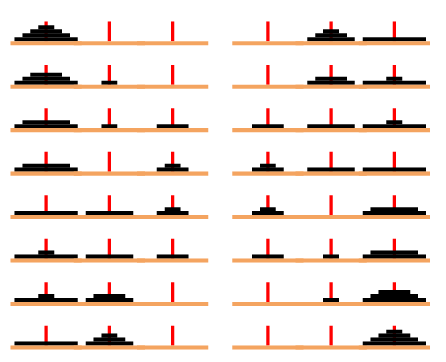Introduction
Tower of Hanoi, invented by E. Lucas in 1883, is a mathematical puzzle where we have three rods and n disks. The objective is to move the entire stack to another rod, and follow some simple rules below:
- Only one disk can be moved at a time.
- A disk can only be moved if it is the uppermost disk on a stack.
- No disk may be placed on top of a smaller disk.

Strategy
Let’s assume the left rod called “source”, the middle rod called “dest”, and the right rod called “aux.” We can use a recursive solution for Tower of Hanoi. We assume that the number of moves
We also have
which is also known as the Mersenne numbers.

Implementation
Here’s how the Python code looks:
def tower_of_hanoi(n, source, dest, aux):
# Base Case
if n == 1:
print(f"Move disk 1 from {source} to {dest}", end="\n")
return
# Move (n-1) disks from source to aux.
tower_of_hanoi(n - 1, source, aux, dest)
# Move nth disk from source to dest.
print(f"Move disk {n} from {source} to {dest}", end="\n")
# Move (n-1) disks from aux to dest.
tower_of_hanoi(n - 1, aux, dest, source)
tower_of_hanoi(5, "source", "dest", "aux")Here’s how the JavaScript code looks:
function tower_of_hanoi(n, source, dest, aux) {
if (n == 1) {
// base case of 1 disk, we know how to solve that
document.write("Move disk 1 from " + source + " to " + dest + ".<br/>");
} else {
// Move (n-1) disks from source to aux.
tower_of_hanoi(n - 1, source, aux, dest);
// now move the last disk
document.write("Move disk " + n + " from " + source + " to " + dest + ".<br/>");
// Move (n-1) disks from aux to dest.
tower_of_hanoi(n - 1, aux, dest, source);
}
}Conclusion
The Tower of Hanoi puzzle is a great example of how recursion can more easily solve a problem. Recursion can be used for a variety of tasks including computations, sorting values, and quickly finding a value in a sorted list. The ability to break a problem into smaller pieces (Divide-and-conquer Algorithm) is a valuable skill for computer programming.

